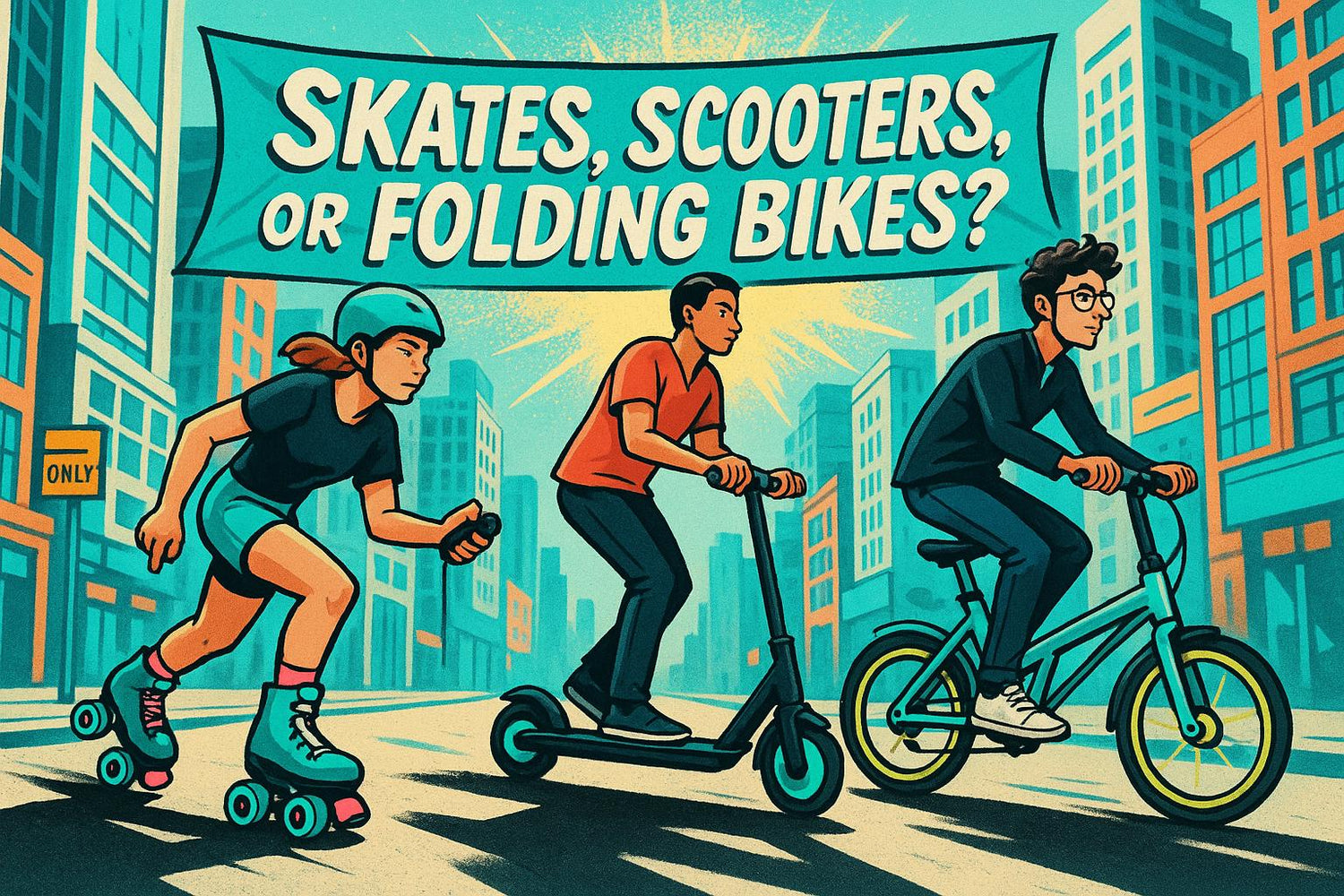Looking for the cheapest way to commute in the city? Here's the breakdown:
- Electric Roller Skates: Cost $599 upfront, offer speeds up to 15 mph, and are great for short trips. They're portable but struggle on uneven surfaces.
- Electric Scooters: Prices vary widely, with low energy costs and decent durability. Maintenance, like replacing tires or batteries, adds to long-term expenses.
- Folding Bikes: No energy costs and lower maintenance overall. They last for decades but require physical effort, especially on longer or hilly routes.
Quick Tip: For short commutes, roller skates are compact and fun. Scooters balance speed and range but add maintenance costs. Folding bikes win for long-term savings and zero energy costs.
| Feature | Roller Skates | Scooters | Folding Bikes |
|---|---|---|---|
| Upfront Cost | $599 | Varies | Moderate |
| Energy Cost/Mile | Low | Low | None |
| Effort Required | Low | Low | High |
| Maintenance | Low | Moderate | Moderate |
| Lifespan | Moderate | Moderate | Long-lasting |
Your choice depends on your budget, commute distance, and storage needs.
1. Electric Roller Skates
Electric roller skates are gaining traction as a fun and eco-conscious way to navigate urban areas. Let’s take a closer look at the purchase price and what it offers.
Purchase Price
Wheelfeet electric roller skates come with a price tag of $599. This cost includes modern features like a wireless remote control, built-in charging capabilities, and a powerful motor. Along with the skates, you’ll also get a complete charging system, ensuring you’re ready to roll right out of the box.
This upfront investment makes electric roller skates a solid mid-range option for those looking to commute in style and with ease.
2. Electric Scooters
When figuring out the cost per mile for an electric scooter, you need to consider several factors: the initial purchase price, ongoing maintenance, energy consumption, and the scooter's overall lifespan. These scooters are popular for urban commutes thanks to their portability, performance, and efficiency. Let’s break down the costs involved before moving on to folding bikes.
Purchase Price
The price of an electric scooter largely depends on its features and performance. Basic models are more affordable and cover essential needs. On the other hand, premium options with features like extended battery life and sturdier construction come at a higher price.
Maintenance Costs
Maintenance typically involves replacing tires, servicing batteries, and changing brake pads. How often you’ll need these services - and how much they’ll cost - depends on how frequently and intensely you use the scooter, as well as the conditions you ride in.
Energy Cost Per Mile
Electric scooters are known for being energy-efficient. They use very little electricity per mile, which keeps charging costs low. While the exact energy cost depends on your local electricity rates and the scooter’s efficiency, this expense is usually a small part of the overall cost.
Lifespan
The lifespan of an electric scooter depends on several factors, including its build quality, how well it’s maintained, and how often it’s used. Batteries, in particular, play a big role in durability, as does exposure to harsh weather conditions.
3. Folding Bikes
Folding bikes bring a practical twist to urban commuting by merging the perks of cycling with the ease of compact storage. Unlike electric bikes, they don't require any energy costs, as they run purely on human effort. This makes them a great option for anyone focused on keeping transportation costs low.
Maintenance Costs
Keeping a folding bike in good shape is key to extending its lifespan. Routine maintenance can range from small fixes costing around $5 to full servicing that might go up to $350, with the average hovering near $60. Over the course of a year, expenses for items like tires, tubes, chains, brake pads, and professional tune-ups usually stay under $500. Factors like how often you ride and your weight can influence these costs - daily riders and heavier cyclists might notice wear and tear more quickly. Typical services include things like fixing a flat, replacing tires, or adjusting brakes, with most routine jobs falling between $5 and $60.
"Having a bike to get around in your area is the most economical choice after walking. After all, there's no gas or fare to pay for. However, you need to maintain your bicycle regularly."
― Airtasker US
"Skipping your routine maintenance schedule can feel like saving money. In reality, it can cost you more in the long run."
― Airtasker US
By sticking to regular maintenance, folding bike owners not only save on costs but also enjoy the bonus of zero energy expenses.
Energy Cost Per Mile
Because they rely solely on human power, folding bikes don't add any energy costs to your budget.
Lifespan
When properly maintained, folding bikes can last for decades. They don't come with the battery-related issues of electric bikes, and their ongoing maintenance costs are often far lower than what you'd spend on a car per mile.
sbb-itb-bf837b9
Pros and Cons
When it comes to choosing the best urban commuting option, weighing the pros and cons of each choice can help you make an informed decision. Here's a breakdown of the strengths and weaknesses of electric roller skates, electric scooters, and folding bikes, along with a handy comparison table to simplify things.
Electric Roller Skates
Electric roller skates offer a lightweight, eco-friendly commuting option that’s easy to carry around. They’re compact, affordable, and require minimal practice to get started. However, they don’t perform well on uneven surfaces or in poor weather conditions, which can limit their usability.
Electric Scooters
Electric scooters are known for their ease of use and adaptability to various urban terrains. They strike a good balance between speed and range, making them a reliable option for city travel. On the downside, even foldable models can be somewhat bulky, which makes storage tricky. Leaving them outdoors increases the risk of theft, and over time, battery replacement costs can add up.
Folding Bikes
Folding bikes are a durable, energy-free commuting option that also doubles as a workout. Their foldable design is perfect for urban environments, especially where indoor storage is available. However, they demand more physical effort, especially on hilly routes, and long rides in hot weather can be uncomfortable.
To make things clearer, here’s a quick side-by-side comparison of the key features:
| Feature | Electric Roller Skates | Electric Scooters | Folding Bikes |
|---|---|---|---|
| Portability | Extremely portable | Good – foldable but bulkier | Compact when folded |
| Storage Space | Minimal | Moderate | Moderate |
| Learning Curve | Short practice required | Easy to master | Easy to master |
| Weather Dependency | High | Moderate | Low |
| Theft Risk | Low (indoor storage easy) | Higher when left outdoors | Low (if stored indoors) |
| Physical Effort | Low | Low | High |
| Terrain Flexibility | Limited | Good | Excellent |
| Maintenance Needs | Low | Moderate | Moderate |
When it comes to cost, electric options like roller skates and scooters will involve energy expenses and potential battery replacements. Folding bikes, on the other hand, mainly require routine upkeep, making them a cheaper long-term choice. For shorter daily commutes of 3 to 5 miles, the energy costs of electric options can start to add up compared to the minimal operating costs of a folding bike.
Finally, consider your city’s infrastructure. Smooth sidewalks and bike lanes can make electric roller skates and scooters more enjoyable to use. For folding bikes, secure indoor storage and bike-friendly routes can maximize their practicality.
Conclusion
The cost-per-kilometer breakdown highlights the strengths of each transportation option. Electric roller skates are ideal for short commutes, combining a reasonable upfront cost, a compact design, and sufficient range. Folding bikes, on the other hand, shine with the lowest ongoing costs, thanks to zero energy consumption and minimal upkeep. Meanwhile, electric scooters strike a balance, offering powered assistance that works well across diverse urban landscapes.
When deciding, think about your average travel distance, the storage space you have, and the infrastructure in your area. Whether you prioritize portability, energy savings, or adaptability, choosing the right option can help you save money while supporting your eco-friendly transportation goals.
FAQs
What should I consider when deciding between electric roller skates, scooters, and folding bikes for commuting?
When deciding between electric roller skates, scooters, and folding bikes for your commute, it’s important to weigh factors like portability, cost, maintenance, and comfort.
- Electric roller skates are incredibly compact - small enough to fit in a backpack. However, they come with a price tag ranging from $200 to $1,000.
- Electric scooters are a more affordable option, starting around $300. They’re foldable for easy storage but can be a bit bulkier to carry.
- Folding bikes stand out for their durability and ability to handle uneven terrain. That said, they usually come with higher upfront costs and demand more maintenance.
Your choice largely depends on your daily route, storage options, and personal needs. If you prioritize portability and ease of use, skates or scooters might work best. On the other hand, if you’re tackling longer commutes or rougher paths, a folding bike could be the way to go. Whichever you choose, all three are eco-friendly and can fit into a variety of budgets and lifestyles.
What are the differences in maintenance costs and needs for electric roller skates, scooters, and folding bikes?
Maintenance needs and costs differ between electric roller skates, scooters, and folding bikes. Here’s how they stack up:
Electric roller skates are the simplest to maintain. They mainly require basic tasks like keeping the battery in good shape and occasional cleaning. Yearly expenses for upkeep usually fall between $50 and $200.
Electric scooters demand more regular care. This includes checking the brakes, maintaining the tires, and ensuring the battery is in good condition. Expect to spend around $50 to $150 per year on maintenance.
Folding bikes, especially electric ones, need periodic attention, such as inflating tires, lubricating the chain, and adjusting brakes. Maintenance costs vary based on how often you use the bike but are generally in the same range as scooters.
In summary, electric roller skates are the easiest and most low-maintenance option, while scooters and folding bikes require more frequent attention to stay safe and perform well.
What are the long-term savings of choosing a folding bike over electric roller skates or scooters for city commuting?
Folding bikes can be a smart choice for long-term savings, especially when compared to electric scooters or roller skates. With an average lifespan of 5–7 years, these bikes are designed to endure and require less frequent maintenance. This durability means fewer repair costs and more money saved over time. On the other hand, electric scooters often need replacement within just 2–3 years and tend to have higher upkeep expenses, making them a less cost-effective option in the long run.
While folding bikes typically come with a higher upfront price tag - ranging from $1,000 to $1,200 - their longevity and lower maintenance costs make them a more budget-friendly option for eco-conscious city commuters. When you factor in their extended usability and reduced upkeep, folding bikes prove to be a practical investment for anyone looking for reliable and cost-efficient transportation.




Leave a comment
All comments are moderated before being published.
This site is protected by hCaptcha and the hCaptcha Privacy Policy and Terms of Service apply.